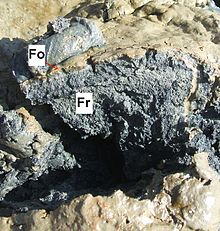Watt (soil type)
The mudflat soil type forms on areas that are inundated by tides twice a day . In the temperate latitudes , these are the areas of the eponymous mudflats where there is no vegetation. In Germany, mud flats are still largely subject to natural influences, despite the North Sea coast's great tourist importance. The soil, made up of marine sediments, has two horizons that differ greatly in color. In the German Soil Systematics , it is assigned to class I ( semi-subhydric soils ). The abbreviation for the soil type is IW. In the international soil classification World Reference Base for Soil Resources (WRB), the tidal flats belong predominantly to the Gleysols with Tidalic Qualifier.
On World Soil Day 2019, this soil type was declared soil of the year 2020 by the soil protection commission at the Federal Environment Agency .
Origin and Distribution
On shallow coasts with more or less pronounced tides there are soils that periodically (twice a day) dry out. Large amounts of material are displaced by the current of the tides. The soil is exposed to constant erosion and sedimentation . In addition to the constantly moving surface, the sea water leads to high salt loads. In the temperate climates no higher plants can settle under these conditions, so that the mud flats are completely free of vegetation. In tropical regions, mangrove forests form on the surfaces .
By far the largest share of the area has the marine mudflats , in which there is seawater with high salt contents. Small areas are also formed by the estuarine tidal flats with brackish or fresh water . These areas are located on the edges of rivers whose water levels are influenced by the tides.
The area of the North Sea coast is one of the largest wadden regions in the world.
Horizon sequence
The general leveling of the marine mudflats is: zFo / zFr
- zFo: On the surface lies the brownish to intensely orange zFo horizon, which is only a few millimeters thick. "F" stands for a horizon at the bottom of the water with usually> 1% organic matter. The introduced "z" means rich in salt, which is due to the sea water. The following letter refers to the redox potential of the soil, which, roughly speaking, represents an indication of the availability of oxygen. The ventilation is still high immediately on the surface. The conditions are thus oxidative ("o").
- zFr: Directly below is the intensely black zFr horizon. The “r” stands for a reductive redox potential. The ventilation is therefore poor, so that the soil is oxygen-free ( anaerobic ). The floor of this horizon has an intense odor of rotten eggs due to its usually significant hydrogen sulfide content. If the black soil material comes into contact with air, it oxidizes relatively quickly, so that in a few hours it becomes as orange as the zFo horizon.
The estuary mudflats are very similar to the marine mudflats; but has no salinization because of the fresh water. The preceding letter “z” is therefore missing, so that the horizon designation is Fo / Fr.
The intense black coloring of large areas of the soil is due to anaerobic processes. The tides deposit organic matter twice a day. This is not composed of resinous or woody plant parts and larger animal bodies, as on land, but consists mainly of broken cells, small-grated algae residues and plankton . This substrate is very easily decomposed. As a result, as soon as the tide sets in, there is a sudden breakdown, which leads to a lack of oxygen. Only the top millimeters of the soil are still ventilated and provide aerobic conditions. Underneath, there is a lack of oxygen and anaerobic bacteria begin to breathe other substances . Most important in terms of quantity, as they are present in large quantities, are sulfates, which are converted to sulfides ( desulfurication ). This creates the hydrogen sulphide, which is responsible for the smell of the mudflats, and the strong black iron sulphide (FeS), which is also responsible for the sulfur dynamics of the marshy soils . If the turnover is very high, the anaerobic zones can reach the surface of the tidal flats, so that so-called "black spots" form. The soil is not dead, as is often written in the press, but anaerobic. Black spots indicate a very high amount of nutrients.
A high lime content from grated mussel shells is typical for many mud flats. The pH value of the soil is therefore in the upper range (approx. PH 7).
use
Wadden soils are highly productive soils that are the basis of food for many living things. The German North Sea coast is an important tourist area and is also used by the local population. Despite its diverse uses, the mudflats can be seen as an area with strong natural influences that shapes itself to a large extent. The German Wadden Sea is a World Heritage Site and a national park .
literature
- Ad Hoc Working Group Soil (2005): Soil Science Mapping Instructions . 5th edition, ISBN 3-510-95920-5 .
- W. Amelung, H.-P. Blume , H. Fleige, R. Horn, E. Kandeler , I. Kögel-Knabner , R. Kretschmar, K. Stahr , B.-M. Wilke: Scheffer / Schachtschabel textbook of soil science. 17th edition. Heidelberg 2018. ISBN 978-3-662-55870-6 .
Individual evidence
- ↑ Ecologically valuable: Watt is “Soil of the Year” at ndr.de from December 4, 2019

